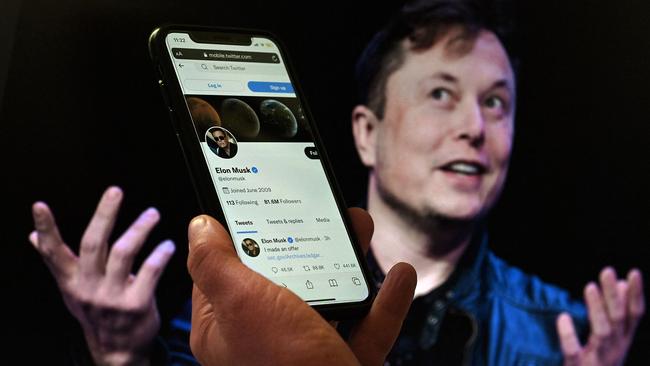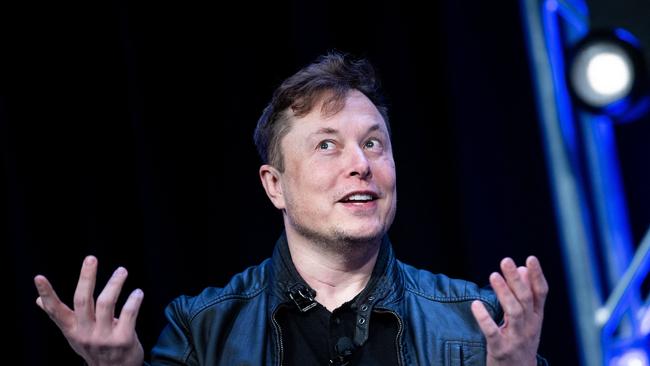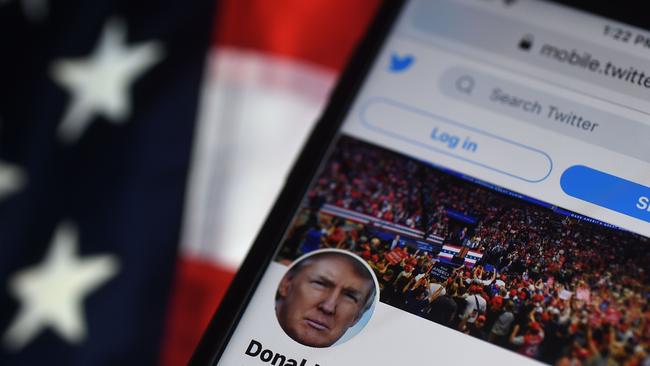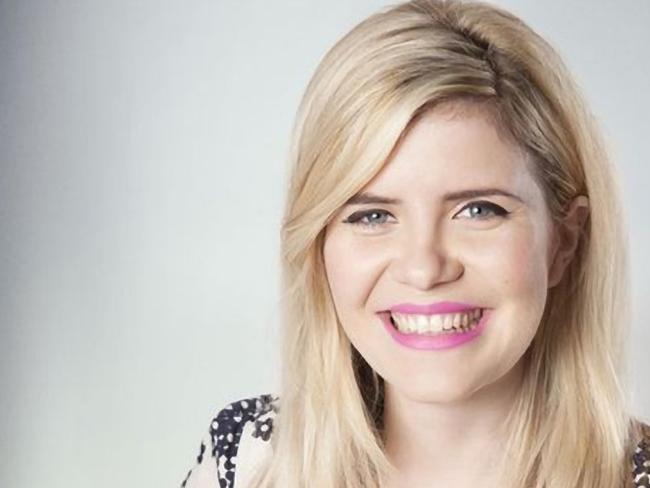Saddle up Elon Musk, Twitter town’s already a Wild West at the crossroads
Posts on the new sheriff’s $US44 billion plaything have an undue influence over politics and media. The next direction could set a toxic tone for years.

If you scrolled through the news sites on Wednesday you would have read about an investigation of sexual misconduct claims against the former BBC DJ Tim Westwood; about witness reports from a pro-Ukraine rally in the occupied city of Kherson; and about the withdrawal from bookshops of one of the Biff, Chip and Kipper children’s books after an outcry over depictions of apparently Muslim characters who are described as “scary”.
These news stories, which would appear at first glance to have little in common, all had the same source: Twitter.
To the casual observer, the interest generated by Elon Musk’s $US44 billion ($62 billion) buyout may seem baffling. Twitter has 329 million users, a modest number next to Facebook’s three billion.
It is used less often than YouTube and by an older demographic than TikTok. It is a minnow in the social media swamp, but its influence on public life is huge.
Twitter was where many people learnt Michael Jackson had died; it was where mass movements such as Black Lives Matter and #MeToo grew; and it was the stage on which Donald Trump cut loose, before his account was suspended in January last year. It has been a key tool in cataloguing Russian war crimes in Ukraine.
It has also evolved rapidly. When the writer and broadcaster Helen Lewis joined in 2007, the site was all about harmless fun.
“It felt like an anarchic community, full of jokes and silliness – dumb stuff like ‘Replace a word in a film title with cheese’,” Lewis says.
The mood changed in about 2014. “It became much nastier and more tense. Then came Brexit, Trump, Corbyn, the gender wars … The divisive politics of the past few years has often made social media feel like a wasteland patrolled by angry wolves who are ready to jump on any stray comment.”
For some, this undercurrent of anger and discord poses a very real threat. In a recent essay for the magazine The Atlantic, the American social scientist Jonathan Haidt goes as far as to argue that social media has weakened democracy.
“Social scientists have identified at least three major forces that collectively bind together successful democracies: social capital (extensive social networks with high levels of trust), strong institutions and shared stories. Social media has weakened all three,” he writes.
Speaking to me from his office in New York, he has no doubt which site is doing the most harm: “The single most destructive platform for democratic institutions, I believe, is Twitter.”
That is why Musk’s takeover, and his absolute commitment to free speech, matters so much. Twitter stands at a crossroads, and the direction in which it heads off could set the tone for years to come.

The questions of what we should be able to say online and how we should be able to say it are ones that all social media companies have wrestled with – none more than Twitter. The platform was not just spawned from the libertarian engineering culture that built the internet; it was its greatest cheerleader – “the free speech wing of the free speech party”, as its founders used to say.
Many of Twitter’s problems are built into its DNA. The original 140-character limit left no room for nuance.
With little accountability or risk of punishment, there has never been a reason to behave. Nor has anyone really been thinking about the impact the site might have on the human brain.
In 2020, when Haidt was invited to give a talk to Twitter staff, the company employed only one social scientist.
Pamela Rutledge, a media psychologist, says negative news and negative emotions spread faster than positive ones: “People get a biased view of the world as more negative or hostile than it actually is. It activates the fight-or-flight syndrome, which increases aggression.”
C Thi Nguyen, a philosopher at the University of Utah, argues Twitter has “gamified” conversation by giving “immediate, vivid and quantified evaluations of one’s conversational success. Twitter offers us points for discourse; it scores our communication.” If a nasty or aggressive tweet is shared and liked more, our reward instinct is triggered and we think of more of the same kind of thing to say.
A libertarian ideology combined with chaotic management made sure Twitter remained a Wild West longer than any other platform.
When Leslie Miley joined the company as head of security in 2013, there was a 20-step complaints procedure to have a graphic or abusive tweet removed, and even then the success rate was less than 50 per cent. When Miley’s team reduced it to an eight-step process, the number of complaints doubled.
Miley, who has since left Twitter, remembers a meeting about online safety shortly after Twitter had bought the video service Vine.
He raised his concerns: “People are going to live-stream rapes and killings, all sorts of bad things are going to happen and this is not going to end well.” The response was ambivalence. “It is not our place to stop that,” he says he was told.

In recent years Twitter has attempted to rein itself in. “The purpose of Twitter is to serve the public conversation,” said Jack Dorsey, the platform’s co-founder and former chief executive, in 2018.
Since then it has started measuring “conversational health”, the character limit has been extended to 280 and prompts have been introduced to encourage users to read an article before they share it.
Divisive and damaging accounts have been suspended, including those of the far-right Briton Tommy Robinson and Donald Trump.
Haidt is sceptical that any of this has made a difference: “If you have strangers who are not verified human beings interacting on a platform where they are performing, not communicating, then there is no way to make it good.”
Musk says he is a free-speech absolutist, within the bounds of the law. That line will become a lot harder to tread when the Online Harms Bill is passed in the UK and the EU’s Digital Safety Act becomes law.
Has Musk considered this changing landscape? He must be aware that laws on free speech can be inconvenient; he has so far failed to overturn his own legal agreement to have all his tweets relating to Tesla scrutinised by a lawyer before he publishes them.
The other risk Musk faces is that the nastier the site becomes, the more people with influence will leave.
Shortly before his takeover bid, Musk tweeted that many of the 10 most-followed accounts, including those of Barack Obama and Taylor Swift, rarely said anything. “Is Twitter dying?” he asked.
Leaving only to return again has become a 21st-century cliche, but increasingly people are sticking to their guns.
Broadcaster Helen Lewis left in 2012 only to be accused of flouncing when she returned. She deactivated her account again recently and says the overriding reaction from those who have noticed is envy.
“Many journalists I know have a terrible, dysfunctional relationship with Twitter. They feel they need it to be visible. But they also hate the feeling that at any moment their phone could light up with thousands of people laughing at them or sending them abuse.”

Earlier this year The New York Times updated its guidance for journalists, stating that having a Twitter account was only optional, partly because of harassment problems and partly because “reporters can rely too much on Twitter as a reporting and feedback tool”.
Haidt says: “If journalists were never allowed to tweet, the world would be a better place and journalism would be better, but any journalist who goes off is committing career suicide, because you aren’t going to know what’s happening.”
British politicians who were once encouraged to use Twitter as a means of engagement with constituents have now been encouraged to leave by parliament’s health and wellbeing service.
“It’s the equivalent of dipping their private parts in honey and exposing them to angry bees,” wrote the political journalist Isabel Hardman.
Those who remain on the site are increasingly changing how they use it. Emma Barnett, presenter of Woman’s Hour on BBC Radio 4, was technology correspondent for The Daily Telegraph when Twitter was launched in 2006.
“Whether it’s abusive, whether it’s – in inverted commas – a critique of an interview, whatever it is [that people] are contributing [on Twitter], it is not a request for genuine conversation any more.
“I’m not being treated like somebody who is a real person. I am more of an object.”
Lewis still finds it a useful source of stories but doesn’t look at her mentions or engage with people replying to her tweets.
Twitter has guarded its data closely since growth began to slow, but it does provide a free real-time stream of 1 per cent of all tweets. Using this data, Forbes magazine concluded that between 2012 and 2018 the number of people tweeting each day fell by 100 million, and the number of tweets dropped from 500 million a day to 300 million.
Barnett says more and more accounts are disappearing behind the “private” padlock.
“Let’s make Twitter maximum fun!” Musk tweeted on Wednesday night, but his commitment to free speech raises legal questions – and commercial ones.
Many users, including advertisers, will find it hard to drag themselves away while the mad Musk show is generating so many headlines. But if the platform becomes toxic, advertisers will sever ties.
Lewis does not rule out going back to Twitter, but for now she is enjoying the peace. “Someone asked me last week if it felt like I didn’t have any friends now I’ve left Twitter. I said it was the opposite: it feels like I don’t have any enemies.”
The Sunday Times



To join the conversation, please log in. Don't have an account? Register
Join the conversation, you are commenting as Logout